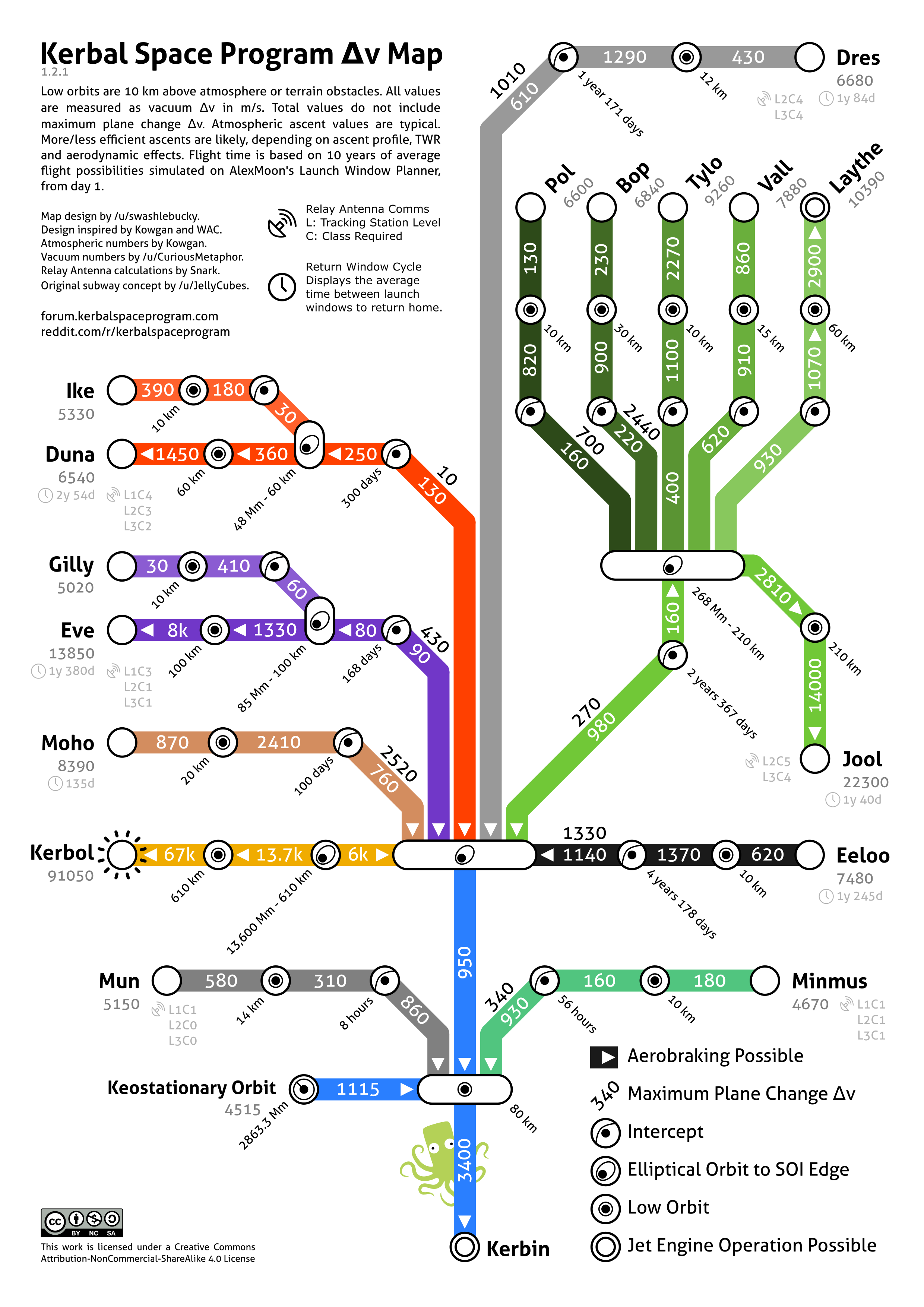Difference between revisions of "Cheat sheet/fr"
m |
|||
| Line 1: | Line 1: | ||
La Bible de l'astronome ''Kerbal Space Program'' : cartes de delta-v, équations et toutes les informations et références qui vous permettront d'aller au bon vous semble dans le système [[Kerbol|kerbollien]], et de revenir. | La Bible de l'astronome ''Kerbal Space Program'' : cartes de delta-v, équations et toutes les informations et références qui vous permettront d'aller au bon vous semble dans le système [[Kerbol|kerbollien]], et de revenir. | ||
| − | traduction de [[ | + | traduction de [[Cheat sheet|la version anglaise]] en cours par ''Mixoupe''. |
== Mathematics == | == Mathematics == | ||
Revision as of 18:38, 23 April 2014
La Bible de l'astronome Kerbal Space Program : cartes de delta-v, équations et toutes les informations et références qui vous permettront d'aller au bon vous semble dans le système kerbollien, et de revenir.
traduction de la version anglaise en cours par Mixoupe.
Contents
Mathematics
Thrust to Weight Ratio (TWR)
- → See also: Thrust-to-weight ratio
This is Newton's Second Law. If the ratio is less than 1 the craft will not lift off the ground. Note that the local gravitational acceleration, which is usually the surface gravity of the body the rocket is starting from, is required.
- is the thrust of the engines
- the total mass of the craft
- the local gravitational acceleration (usually surface gravity)
Combined Specific Impulse (Isp)
- → See also: Specific impulse
If the Isp is the same for all engines in a stage, then the Isp is equal to a single engine. If the Isp is different for engines in a single stage, then use the following equation:
Delta-v (Δv)
Basic calculation
- → See also: Tutorial:Advanced Rocket Design
Basic calculation of a rocket's Δv. Use the atmospheric and vacuum thrust values for atmospheric and vacuum Δv, respectively.
- is the velocity change possible in m/s
- is the starting mass in the same unit as
- is the end mass in the same unit as
- is the specific impulse of the engine in seconds
True Δv of a stage that crosses from atmosphere to vacuum
| Body | Δvout |
|---|---|
| Kerbin | 1000 m/s |
| other bodies' data missing | |
Calculation of a rocket stage's Δv, taking into account transitioning from atmosphere to vacuum. Δvout is the amount of Δv required to leave a body's atmosphere, not reach orbit. This equation is useful to figure out the actual Δv of a stage that transitions from atmosphere to vacuum.
Maps
Various fan-made maps showing the Δv required to travel to a certain body.
Subway style Δv map:
Total Δv values
Δv change values
Δv nomogram
Δv with Phase Angles
Precise Total Δv values
Math examples
TWR
- Copy template:
- TWR = F / (m * g) > 1
Isp
- When Isp is the same for all engines in a stage, then the Isp is equal to a single engine. So six 200 Isp engines still yields only 200 Isp.
- When Isp is different for engines in a single stage, then use the following equation:
- Equation:
- Simplified:
- Isp = ( F1 + F2 + ... ) / ( ( F1 / Isp1 ) + ( F2 / Isp2 ) + ... )
- Explained:
- Isp = ( Force of Thrust of 1st Engine + Force of Thrust of 2nd Engine...and so on... ) / ( ( Force of Thrust of 1st Engine / Isp of 1st Engine ) + ( Force of Thrust of 2nd Engine / Isp of 2nd Engine ) + ...and so on... )
- Example:
- Two engines, one rated 200 newtons and 120 seconds Isp ; another engine rated 50 newtons and 200 seconds Isp.
- Isp = (200 newtons + 50 newtons) / ( ( 200 newtons / 120 ) + ( 50 newtons / 200 ) = 130.89 seconds Isp
Δv
- For atmospheric Δv value, use atmospheric thrust values.
- For vacuum Δv value, use vacuum thrust values.
- Use this equation to figure out the Δv per stage:
- Equation:
- Simplified:
- Δv = ln ( Mstart / Mdry ) * Isp * g
- Explained:
- Δv = ln ( Starting Mass / Dry Mass ) X Isp X 9.81
- Example:
- Single Stage Rocket that weighs 23 tons when full, 15 tons when fuel is emptied, and engine that outputs 120 seconds Isp.
- Δv = ln ( 23 Tons / 15 Tons ) × 120 seconds Isp × 9.81m/s² = Total Δv of 503.2 m/s
True Δv
- How to calculate the Δv of a rocket stage that transitions from Kerbin atmosphere to vacuum.
- Assumption: It takes approximately 1000 m/s of Δv to escape Kerbin's atmosphere before vacuum Δv values take over for the stage powering the transition.
- Note: This equation is an guess, approximation, and is not 100% accurate. Per forum user stupid_chris who came up with the equation: "The results will vary a bit depending on your TWR and such, but it should usually be pretty darn accurate."
- Equation for Kerbin Atmospheric Escape:
- Simplified:
- True Δv = ( ( Δv atm - 1000 ) / Δv atm ) * Δv vac + 1000
- Explained:
- True Δv = ( ( Total Δv in atmosphere - 1000 m/s) / Total Δv in atmosphere ) X Total Δv in vacuum + 1000
- Example:
- Single Stage with total atmospheric Δv of 5000 m/s, and rated 6000 Δv in vacuum.
- Transitional Δv = ( ( 5000 Δv atm - 1000 Δv Required to escape Kerbin atmosphere ) / 5000 Δv atm ) X 6000 Δv vac + 1000 Δv Required to escape Kerbin atmosphere = Total Δv of 5800 m/s












